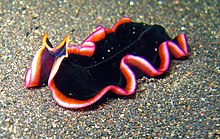
Overview
editPseudocerotidae are simple organisms categorized by their oval bodies and tentacles("Marine Speices Identification Portal",n.d.) and bright colors. They use the cilia to glide along surfaces("pseudocerotidae", n.d.). Most commonly referred to as marine flatworms, closely related to the orders Macrostomorpha and Lecithoepitheliata. These organisms have very complex reproductive systems ("Phylum platyhelminthes - flatworms", n.d.), no blood systems or organs for gas exchange, a simple brain and are hermaphroditic("Turbellaria: Tiny, Non-Parasitic Flatworms Including Acoela & Tricladida", n.d.).
Domain: Eukarya
Kingdom: Animalia
Phylum: Platyhelminthes
Class: Turbellaria
Order: Polycladia
Family: Pseudocerotidae
Habitat
editDue to the anthropogenic transportation of non-native marine species, their species can be found all around the world in tropical and subtropical waters near coral reefs ("First record of...",2010), shallow reefs, deep waters, water surfaces and in aquaculture areas ("Neotype Designation for the Marine Flatworm...", 2018). The most biodiverse areas with these species are the Caribbean and Indo-Pacific regions ("Two new ...", 2021).
Diet
editThe feeding methods of pseudocerotidae are most intriguing, due to their soft bodies and slow movements they must prey on other organisms with little to no movement. This is why their diet is composed of scavenging for various sponges, other stationary or dead invertebrates. They use their sensory detectors to chemically sense their food. The food is digested before entering the body. Then the food travels through their pharynx, "...which can then grow to be the size of the whole flatworm" ("Pseudoceros bifurcus", n.d.).
Phenology
editPolycladia are typically distinguished by their hermaphroditic reproductive system and their external anatomy such as their eyespot arrangement, pharynx and tentacles ("Neotype Designation for the Marine Flatworm...", 2018). In an experiment Pseudoceros and Pseudobiceros were previously based on their reproductive systems, the two groups of Pseudocerotidae were divided into groups through their genetic difference. A difference in an expansive segment of 28S rDNA, showed small genetic difference in the species Pseudoceros bifurcus.("A molecular framework...", 2001).
Reproduction
editPenis fencing is not purely for reproduction and is not an aggressive battle of insemination, it is a mating ritual that can result in insemination of both individuals willfully. A few species show long term care for their young, this care is typically shown in species that have smaller offspring sizes. While larger offspring sizes with faster development in species cause little care for the young after birth. The egg capsules produced are most commonly smooth and round, except for a few species where they have pointed opercula.("Mating behavior...", 2020). Egg capsules can reach thousands, in a study the number of eggs for two different flatworms were 1,307 and 3,073 ("Penis fencing, spawning,...", n.d.).
References
edit1. Chim, Ong, R. S. L., & Gan. (n.d.). Penis fencing, spawning, parental care and embryonic development in the cotylean flatworm Pseudoceros indicus (Platyhelminthes: Polycladida: Pseudocerotidae) from Singapore. Proxy login - university libraries - USC. Retrieved April 10, 2022, from https://www-webofscience-com.pallas2.tcl.sc.edu/wos/bci/full-record/BCI:BCI201500692391
2. Dixit, S., Bulnes, V. N., & Raghunathan, C. (n.d.). Neotype designation for the marine flatworm, Acanthozoon ...Retrieved April 12, 2022, from http://zoolstud.sinica.edu.tw/Journals/57/57-45.pdf
3. Dixit, S., Manjebrayakath, H., & Saravanane, N. (2021). Two new 0RW1S34RfeSDcfkexd09rT2Pseudoceros1RW1S34RfeSDcfkexd09rT2 (Platyhelminthes: Polycladida: Pseudocerotidae) from Agatti Island, India and a species checklist from Indian waters. Marine Biological Association of the United Kingdom.Journal of the Marine Biological Association of the United Kingdom, 101(2), 253-263. http://dx.doi.org/10.1017/S0025315421000151
4. Khalili, Z., Rahimian, H., & Pazooki, J. (2010). First record of the family pseudocerotidae (platyhelminthes, polycladida, cotylea) from the persian gulf, iran. ZooKeys, 31, 39-51. doi:http://dx.doi.org/10.3897/zookeys.31.136
5. Litvaitis, M. K., & Newman, L. J. (2001). A molecular framework for the phylogeny of the pseudocerotidae (platyhelminthes, polycladida). Hydrobiologia, 444(1-3), 177-182. doi: http://dx.doi.org/10.1023/A:1017503124908
6. “Marine Species Identification Portal.” Marine Species Identification Portal : Family Pseudocerotidae, http://species-identification.org/species.php?species_group=turbellaria&menuentry=groepen&id=84&tab=beschrijving.
7. National Museum of Natural History. (2018). Pseudocerotidae. EOL. Retrieved April 12, 2022, from https://eol.org/pages/46478730
8. Phylum platyhelminthes - flatworms. SEANET. (n.d.). Retrieved April 12, 2022, from https://seanet.stanford.edu/Platyhelminthes
9. Pseudoceros Bifurcus. Flatworm Classifications. (n.d.). Retrieved April 12, 2022, from http://bioweb.uwlax.edu/bio203/s2014/tran_tram/classification.htm
10. Ramel, G., & About The Author Gordon Ramel Gordon is an ecologist with two degrees from Exeter University. He's also a teacher. (2020, July 24). Turbellaria: Tiny, non-parasitic flatworms including Acoela & Tricladida. Earth Life. Retrieved April 12, 2022, from https://www.earthlife.net/inverts/turbellaria.html
11. Samantha Jia, W. T., & Ong, R. S. L. (2020). Mating behavior, spawning, parental care, and embryonic development of some marine pseudocerotid flatworms (platyhelminthes: Rhabditophora: Polycladida) in singapore. Invertebrate Biology, 139(2) doi: http://dx.doi.org/10.1111/ivb.12293
12. Wells, F. E., Tan, K. S., Todd, P. A., Jaafar, Z., & Yeo, D. C. J. (2019). A low number of introduced marine species in the tropics: A case study from singapore.Management of Biological Invasions, 10(1), 23-45. Retrieved from https://login.pallas2.tcl.sc.edu/login?url=https://www.proquest.com/scholarly-journals/low-number-introduced-marine-species-tropics-case/docview/2285117784/se-2